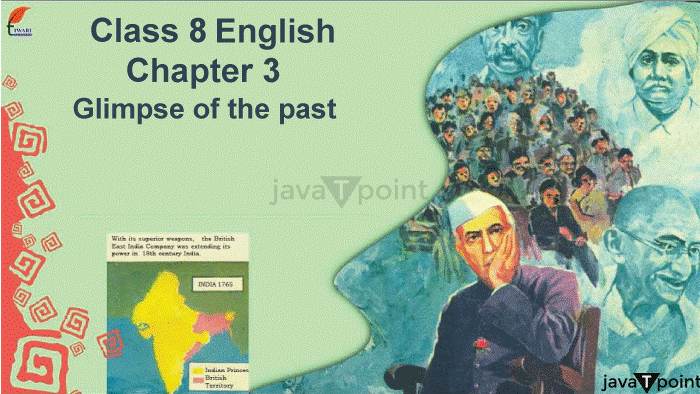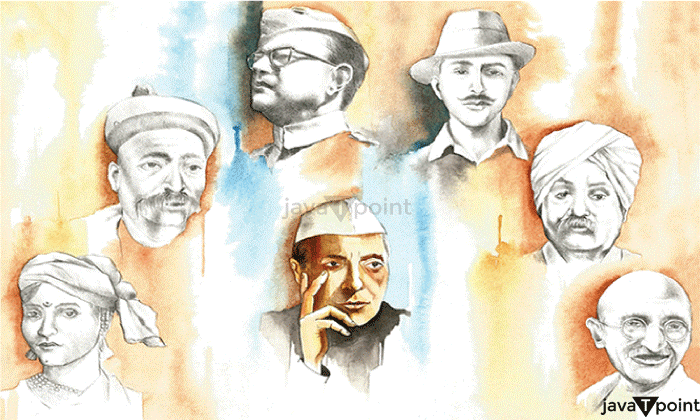Glimpses of the Past Summary Class 8 EnglishShivaji Sawant (31 August 1940 - 18 September 2002) was an Indian Marathi novelist. He is renowned as Mrityunjaykaar (Mrityunjay's Maker) for writing the well-known Marathi novel Mrityunjay. In 1994, he became the first Marathi writer to get the Moortidevi Award. Mrityunjay (English: Triumph Over Death) is based on Karna, a significant character in the epic Mahabharat. This novel received several honors and praises after being translated into Hindi (1974), English (1989), Kannada (1990), Gujarati (1991), and Malayalam (1995).His book Chhava, released in 1980, is based on the life of Sambhaji. He has been the Maharashtra Sahitya Parishad's vice-president since 1995. In 1983, he was the president of the Baroda Sahitya Sammelan. 
IntroductionThe chapter presents a concise and extensive description of events in our country from 1757 to 1857. It comprises occurrences that triggered massive revolts during the First War of Independence. It demonstrates how the British East India Company expanded its dominance in India by exploiting Indians, stealing landlords and farmers' land, causing famines, and encouraging patriots to commit horrible acts against humanity. The Plot of the StoryS.D Sawant wrote the lesson "Glimpses of the Past," adapted from the book "Our Freedom Movement." The lesson is written in the style of a comic strip. A comic strip is a series of drawings and speech bubbles made to tell a narrative engagingly. It facilitates the readers' understanding of the story. The chapter "Glimpses of the Past" displays British rule in India from 1757 to 1857. The introduction of Britishers in India drastically changed people's lives. They mistreated the Indians and began to dominate them. The British exploited the local people by exacting heavy taxes and holding peasant and farmer lands. After witnessing the people's poverty and suffering, numerous freedom fighters came together to help free India from British oppression. As a result, it opened the way for the First Indian War. The lesson's main topics include religious belief, tremendous battles, life's struggles, and famine. Character SketchRaja Ram Mohan RoyRam Mohan Roy was a knowledgeable Bengali man who cherished his Indian heritage yet recognized the need for social reform. He realized that the core of all religions was the same. As a result, respect and tolerance are essential for a healthy social existence. Meanwhile, he was drawn to scientific and modern-day forms of knowledge and concluded that everything that could be explained logically should be recognized as valid information. He went to England and later accepted British authority, but only if they were prepared to keep their commitments to their Indian people. He also started newspapers in India, which were quickly shut down by the suspicious British in 1823. Sepoy Mangal PandeyMangal Pandey is a well-known independence warrior in Indian history. He devoted his life to liberating the country from British rule. He is primarily regarded as one of India's early independence warriors. He is regarded as a Sepoy mutiny of 1857 participant who played an essential role in the 1857 revolt. On 19 July 1827, he was born in the village of upper Ballia district in Uttar Pradesh to a Brahmin family in Nagwa. He was well-known for his involvement in many attacks against army commanders. In 1849, he joined the East India Company. Tatya TopeTantia Tope, also known as Tatya Tope or Tantia Topi, was a leader of the Indian Mutiny of 1857-1858. Despite having no official military experience, he was most likely the rebels' best and most successful commander. Tantia Tope was a Maratha Brahman who served for Baji Rao, the Maratha confederacy's former Peshwa (ruler), and his adopted son Nana Sahib, who was also active in the rebellion. On 6 December, Tantia Tope was defeated by Sir Colin Campbell (later Baron Clyde) but stayed in Kalpi. In March 1858, he marched to Jhansi to relieve Rani (queen) Lakshmi Bai, whom British forces had surrounded. He was defeated again and greeted the retreating rani at Kalpi before making a victorious run to Gwalior on 1 June. His troops disappeared on 19 June, but he continued to fight as a guerilla warrior in the woods until he was betrayed in April. At Shivpuri, he was tried and killed. 
Tipu SultanTipu Sultan was known as the 'Tiger of Mysore' because he battled bravely against the tiger. He was Haider Ali's son and became Mysore's king in 1782. Because the British East India firm had a profitable business on the Malabar coast, Tipu Sultan decided in 1785 to restrict the export of sandalwood, pepper, and cardamom and to stop local merchants from trading with the firm. He skillfully maintained a strong relationship with the French and upgraded his army with their assistance. Tipu Sultan died at the battle of Seringapatam while defending his city Seringapatam. He was ambitious and dangerous for the British, posing a challenge to their control. Because of such Indian kings, we have always remained a unified country and have successfully fought for our independence from British rule. SummaryThe chapter opens with events that took place in 1757. At the time, the British held a commanding position in India. They had superior weaponry and ammunition, as well as substantial financial resources. The Indian states and rulers, on the other hand, were short-sighted and preoccupied with fighting among themselves. They required more unity. They also regularly sought British help, which the East India Company fully exploited. The British adopted the 'Divide and Rule strategy' to conquer the princes. Some people backed the British, while others did not. In contrast, Tipu Sultan of Mysore fought alongside the British. Unfortunately, he perished in 1799 during the Fourth Anglo-Mysore War. The chapter looks deeper into the social fabric from 1765 to 1836. Religious leaders encouraged terrible social practices like untouchability, child marriage, Sati pratha, etc. Because the British disliked the Indians, the Indians lost their self-respect. The British heavily taxed farmers. They even cut the thumbs of skilled painters. Imports from England, on the other hand, were free from duty. Thus, the British sought to maximize profit and wealth at whatever cost. Between 1772 and 1833, Raja Ram Mohan Roy began his efforts to change Indian civilization. For the same reason, he formed the Brahmo Samaj and communicated the belief that all faiths' essential teachings and values are the same. He also established newspapers in India. He was an outspoken opponent of atrocities such as Sati pratha, polygamy, child marriages, and the caste system. He was a driving force towards the eradication of Sati pratha. In 1818, the British Parliament passed the Third Regulation Act. It argues that during an era of Indian oppression, an Indian might be imprisoned without a legal trial. By 1829, British exports were worth seven crore rupees. While Indian enterprises struggled, British businesses thrived. The British educated clerks to run the administration as if that wasn't enough. As a result, Lord Macaulay advocated in 1835 that English be used as the teaching medium. This education system also produced intellectuals who recognized the British Raj's flaws and educated their fellow Indians. India had become a completely administered British colony by 1856. As the violence reached its height, revolts occurred. In 1855, the Santhals revolted against the British and killed their servants. The first Sepoy Mutiny occurred in 1857 when Mangal Pandey was hanged. The sepoys marched towards Delhi, chanting, "Bahadur Shah Zafar!" Landlords also backed this effort. People handed out chapattis with the message that their local king needed their help. The Indian soldiers were also given a lotus flower. Many princes, including Hazrat Mahal of Lucknow, Maulvi Ahmadullah of Faizabad, Tatya Tope and Peshwa Nana Saheb of the Maratha empire, and Kunwar Singh of Bihar, joined the uprising, which marked the beginning of the Indian liberation battle. AnalysisThe lesson is on the Indian independence movement. 'United we stand, divided we fall,' says this chapter. The British arrived in India to trade, but they conquered the Indian kings when they discovered flaws in their governance. They targeted the locals by raising taxes and imprisoning them. However, the Indian side of the rebellion began with the arrival of leaders such as Raja Ram Mohan Roy. In 1857, Indian armies faced off against British forces. Battles took place throughout northern India to free our nation from British oppression. It also teaches us that we must be organized to be successful in everything we do. |
 For Videos Join Our Youtube Channel: Join Now
For Videos Join Our Youtube Channel: Join Now
Feedback
- Send your Feedback to [email protected]
Help Others, Please Share









